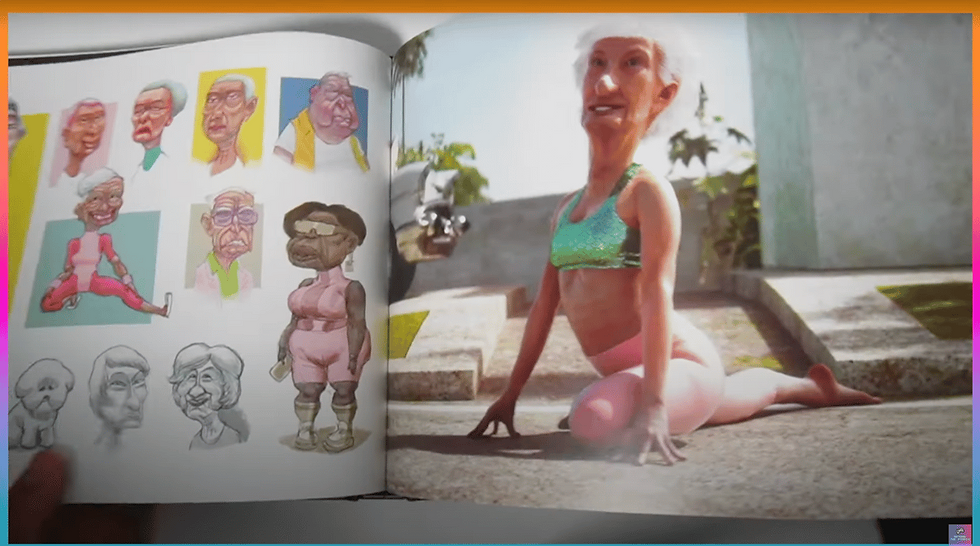The Art of Love, Death & Robots – A Visual Masterpiece for Animation Fans.
- hazbeyondthepixels
- Feb 23
- 4 min read

Few animated anthologies have pushed the boundaries of storytelling and visual artistry like Netflix’s Love, Death & Robots.
With its stunning animation, bold narratives, and sheer variety of artistic styles, the series is a love letter to animation as an art form. Now, for fans of the show and anyone passionate about visual storytelling, The Art of Love, Death & Robots is an absolute must-have.
This massive art book, covering all three seasons of the show, isn’t just a collection of pretty pictures—it’s a deep dive into the creative process, featuring interviews, breakdowns, and behind-the-scenes insights that will inspire animators, filmmakers, and creatives alike. Let’s crack it open and see why it deserves a spot on your shelf.

A Deep Dive into Three Seasons of Stunning Animation
At nearly three inches thick, this behemoth of an art book is a treasure trove of concept art, character designs, storyboards, and world-building insights. It covers every episode from all three seasons, giving readers a behind-the-scenes look at how these groundbreaking shorts were crafted.
Inside, you’ll find:
✅ Character and environment concept art that showcases the evolution of each episode’s unique aesthetic.
✅ Storyboards that illustrate how scenes were composed and the level of detail that went into shot planning.
✅ Creator interviews with the visionary directors and artists behind the show, breaking down their creative process.
✅ Color palettes and lighting studies, revealing the choices that shaped each short’s mood and atmosphere.
✅ Explorations of different animation styles, from hyper-realistic CGI to stylized 2D and experimental approaches.

Branding & Iconography – More Than Just a Logo
One of the first things that caught my eye when flipping through The Art of Love, Death & Robots is how much thought went into the show’s branding. This section explores the various iterations of the title and logo, showing how the team arrived at the now-iconic emoji-like branding.
It’s a great reminder that branding isn’t just about creating a logo—it’s about capturing the essence of a project. Even for a show as visually diverse as Love, Death & Robots, the branding remains consistent and recognizable, tying together all the different artistic styles under one unified vision.
For filmmakers, game developers, or anyone creating a project, this is a masterclass in the power of branding.

The Importance of Storyboarding in Animation
The storyboarding section is another highlight of the book. It’s easy to forget how much work goes into pre-production, but flipping through the highly detailed storyboards in this book is a great reminder of why they’re essential.
Some of the most impressive pages showcase how closely the final animation matches the original storyboards, demonstrating the precision and clarity of the creative vision. Whether you’re an animator, director, or just someone who appreciates the craft, these pages offer a fascinating look at how a simple sketch evolves into breathtaking animation.

A Masterclass in Color and Atmosphere
One of the most visually striking aspects of Love, Death & Robots is its incredible use of colour and lighting. Every episode has a distinctive tone, and The Art of Love, Death & Robots breaks down the colour palettes and lighting techniques used to create those moods.
For example:
🎨 Sonnie’s Edge uses deep blues and neon reds, creating an underground cyberpunk fight club aesthetic.
🎨 The Witness is a bold mix of comic book-style cel-shading with vibrant, surreal colors.
🎨 Zima Blue is minimalistic yet evocative, with its stunning contrast of blues and oranges.
As a game director and filmmaker, this section is pure gold—a reminder of how color and composition influence storytelling.

The Variety of Artistic Styles on Display
One of the most exciting things about Love, Death & Robots is how each episode experiments with a different animation style. Some shorts are hyper-realistic, while others are stylized, abstract, or even painterly.
This book beautifully captures that variety, showcasing the incredible range of animation techniques that make the series so visually dynamic. Whether you’re into CGI, hand-drawn 2D, or experimental animation, you’ll find inspiration on every page.

A Must-Have for Artists, Animators, and Fans
📖 If you’re an animator or visual artist, this book is an invaluable resource—packed with inspiration, workflow breakdowns, and insights from some of the best animators in the industry.
🎮 If you’re a game designer or filmmaker, this book is a masterclass in world-building, lighting, and storytelling through visuals.
🔥 If you’re just a fan of Love, Death & Robots, this is the ultimate collector’s item—a gorgeous coffee table book that you’ll keep coming back to.

Final Thoughts – Why This Book is a Must-Own
The Art of Love, Death & Robots isn’t just a companion piece—it’s a celebration of the power of animation. It reminds us why we fell in love with the series, while also offering deep insights into its creation.
For me, it’s more than just an art book—it’s a source of inspiration. Whenever I hit a creative block, flipping through these pages reminds me why I do what I do. It’s a reminder of the endless possibilities of animation, the importance of collaboration, and the impact of great storytelling.
Whether you’re an artist, filmmaker, animator, or just a fan of incredible visuals, this book is a must-have.
🎨 Where to Get It?You can grab The Art of Love, Death & Robots online from major retailers. If you love animation, do yourself a favor and add this masterpiece to your collection.
What’s Your Favorite Episode?
🔥 Now it’s your turn! What’s your favorite episode of Love, Death & Robots? Let me know in the comments below!
📌 Don’t forget to like, subscribe, and hit that notification bell for more deep dives into animation, filmmaking, and game design!
Until next time—stay creative and keep pushing boundaries! 🚀🎥🎮


